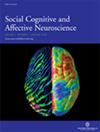The vocal side of empathy: neural correlates of pain perception in spoken complaints
IF 3.1
2区 医学
Q2 NEUROSCIENCES
引用次数: 0
Abstract
In the extensive neuroimaging literature on empathy for pain, few studies have investigated how this phenomenon may relate to everyday social situations such as spoken interactions. The present study used fMRI to assess how complaints, as vocal expressions of pain, are empathically processed by listeners and how these empathic responses may vary based on speakers’ vocal expression and cultural identity. Twenty-four French participants listened to short utterances describing a painful event, that were either produced in a neutral-sounding or complaining voice by both ingroup (French) and outgroup (French-Canadian) speakers. Results suggest that the perception of suffering from a complaining voice increased activity in the Emotional Voice Areas (EVAs), composed of voice-sensitive temporal regions interacting with prefrontal cortices and the amygdala. The Salience and Theory of Mind networks, associated with affective and cognitive aspects of empathy, also showed prosody-related activity and specifically correlated with behavioral evaluations of suffering by listeners. Complaints produced by in- vs. outgroup speakers elicited sensorimotor and default-mode activity, respectively, suggesting accent-based changes in empathic perspective. These results, while reaffirming the role of key networks in tasks involving empathy, highlight the importance of vocal expression information and social categorization processes when perceiving another’s suffering during social interactions.感同身受的声音:口语抱怨中疼痛感知的神经相关性
在有关对疼痛的移情的大量神经影像文献中,很少有研究探讨这种现象如何与日常社交场合(如口语互动)相关联。本研究利用 fMRI 评估了作为痛苦的声音表达的抱怨是如何被听者共情处理的,以及这些共情反应是如何根据说话者的声音表达和文化身份而变化的。二十四名法国受试者聆听了描述痛苦事件的简短话语,这些话语是由本群体(法语)和外群体(法裔加拿大人)的说话者以中性声音或抱怨的声音发出的。研究结果表明,对抱怨声音的痛苦感知增加了情感声音区(EVAs)的活动,情感声音区由对声音敏感的颞叶区域与前额叶皮层和杏仁核相互作用组成。与移情的情感和认知方面相关的 "显著性 "和 "心智理论 "网络也显示出与前音相关的活动,并与听者对痛苦的行为评估特别相关。同组和异组说话者的抱怨分别引起了感觉运动和默认模式活动,这表明移情视角中基于口音的变化。这些结果再次证实了关键网络在移情任务中的作用,同时强调了在社会交往中感知他人痛苦时,声音表达信息和社会分类过程的重要性。
本文章由计算机程序翻译,如有差异,请以英文原文为准。
求助全文
约1分钟内获得全文
求助全文
来源期刊
CiteScore
6.80
自引率
4.80%
发文量
62
审稿时长
4-8 weeks
期刊介绍:
SCAN will consider research that uses neuroimaging (fMRI, MRI, PET, EEG, MEG), neuropsychological patient studies, animal lesion studies, single-cell recording, pharmacological perturbation, and transcranial magnetic stimulation. SCAN will also consider submissions that examine the mediational role of neural processes in linking social phenomena to physiological, neuroendocrine, immunological, developmental, and genetic processes. Additionally, SCAN will publish papers that address issues of mental and physical health as they relate to social and affective processes (e.g., autism, anxiety disorders, depression, stress, effects of child rearing) as long as cognitive neuroscience methods are used.

 求助内容:
求助内容: 应助结果提醒方式:
应助结果提醒方式:


